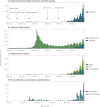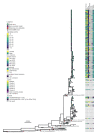The re-emergence of influenza following the COVID-19 pandemic in Victoria, Australia, 2021 to 2022
- PMID: 37707981
- PMCID: PMC10687983
- DOI: 10.2807/1560-7917.ES.2023.28.37.2300118
The re-emergence of influenza following the COVID-19 pandemic in Victoria, Australia, 2021 to 2022
Abstract
BackgroundCOVID-19 pandemic mitigation measures, including travel restrictions, limited global circulation of influenza viruses. In Australia, travel bans for non-residents and quarantine requirements for returned travellers were eased in November 2021, providing pathways for influenza viruses to be re-introduced.AimWe aimed to describe the epidemiological and virological characteristics of the re-emergence of influenza in Victoria, Australia to inform public health interventions.MethodsFrom 1 November 2021 to 30 April 2022, we conducted an epidemiological study analysing case notification data from the Victorian Department of Health to describe case demographics, interviewed the first 200 cases to establish probable routes of virus reintroduction and examined phylogenetic and antigenic data to understand virus diversity and susceptibility to current vaccines.ResultsOverall, 1,598 notifications and 1,064 positive specimens were analysed. The majority of cases (61.4%) occurred in the 15-34 years age group. Interviews revealed a higher incidence of international travel exposure during the first month of case detections, and high levels of transmission in university residential colleges were associated with return to campus. Influenza A(H3N2) was the predominant subtype, with a single lineage predominating despite multiple importations.ConclusionEnhanced testing for respiratory viruses during the COVID-19 pandemic provided a more complete picture of influenza virus transmission compared with previous seasons. Returned international travellers were important drivers of influenza reemergence, as were young adults, a group whose role has previously been under-recognised in the establishment of seasonal influenza epidemics. Targeting interventions, including vaccination, to these groups could reduce future influenza transmission.
Keywords: Influenza; antigenic drift; bottleneck; first few hundred; phylogenetics; travel; university.
Conflict of interest statement
IGB owns shares in a vaccine producing company.
Remaining authors have no conflicts to declare.
Figures



References
MeSH terms
Substances
LinkOut - more resources
Full Text Sources
Medical
Miscellaneous
